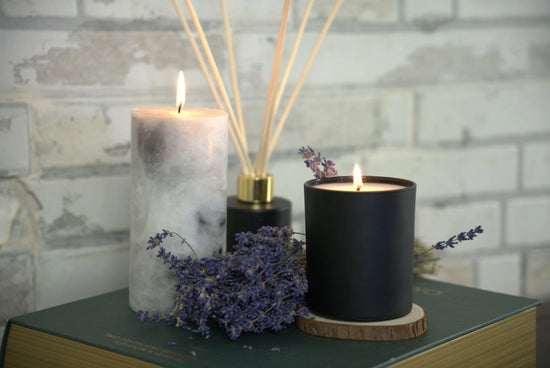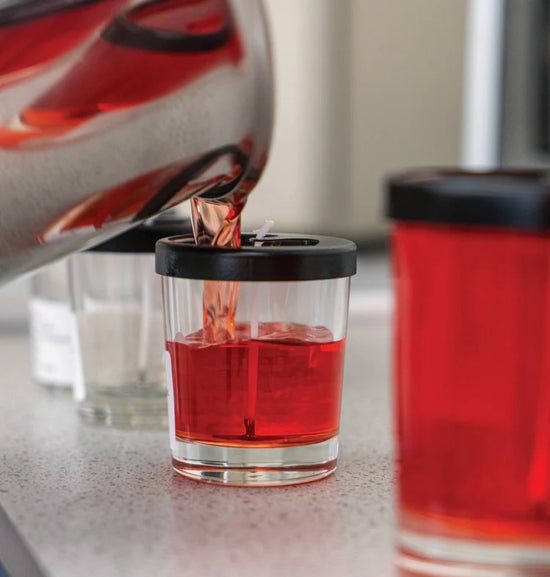What do we mean by a Flame Going Out?
This refers to a candle burning away, not reaching the bottom of the container, and the flame extinguishing without any apparent cause.
Why do flames go out on their own?
To understand why a flame goes out, we must first know how to maintain a stable flame. A flame requires three essential ingredients, known as the fire triangle: fuel, oxygen, and heat. If any of these elements are missing or if the balance is disrupted, the flame will go out.
Fragrance unsuitable for candle-making
One reason could be that your fragrance oil contains non-combustible ingredients that accumulate in the melt pool as the candle burns. Eventually, the melt pool may have so much non-combustible material that it can no longer fuel the flame, causing it to go out. This often occurs with fragrances from generalist stores, as they may not be optimised for candle-making. In this case, you have disrupted the quality of fuel feeding the flame.
Bridging & Unstable Wicks
If you're using the wrong type of wick for your wax and fragrance combination, your wick might "bridge." Bridging happens when the wick doesn't self-trim as it burns, often because the chemical treatment on the wick is too strong for the candle material. A bridging wick can sometimes bend over so far that it immerses itself in the melt pool, extinguishing the flame. Similarly, if the wick wax used has a low melting point, the wick may become unstable and fall into the melt pool. This is especially common when people incorrectly use lower melting point plant waxes as a wick wax. In either instance, the wick is submerged in the liquid pool, removing both oxygen and heat from the fire triangle.
Excessive self-trimming wick
Sometimes, you might notice the flame reduces in size continuously as the candle burns, and the wick becomes very small, eventually causing the flame to go out. This can indicate that the chemical treatment on the wick is too weak or otherwise unsuitable for the candle material. Some fragrance oils not optimised for candle-making can effectively ‘cook’ the wick, turning it into charcoal and preventing any capillary action. This starves the flame of fuel, causing it to go out.
Use of mica powders
If you use mica powder in your fragranced wax, the mica will drift into the melt pool and enter the wick. Over time, the accumulation of mica powder will clog the wick and stop the flow of fuel, causing the flame to go out.
Drafts & Air Currents
Drafts can extinguish a flame by removing the heat required for combustion. This can also happen in multi-wick or deep candle vessels, where hot air currents disrupt the flames, potentially causing sooting or extinguishing the flame.
Wooden Wicks
Because laminar wood wicks are made from a raw natural material, they often have knots and imperfections, which can affect the capillary action of the wick. Whilst wooden wicks have definitely improved in recent years, in terms of consistency, they are still natural products and can go out from time to time.
How do I prevent the flame from going out?
Buy fragrances optimised for candles.
Avoid general craft supply stores that may not have fragrances optimised for candle-making. Instead, shop with suppliers like Candle Shack, where all fragrances are tested and optimised for candle use. We have three full time staff in our laboratory, burn testing candle recipes all day, and we have ~150 fragrances. Be very wary of suppliers who have hundreds of fragrance oils, that are marketed as suitable for candles, soaps, carpet fresheners etc. This essentially means they have been purchased with little or no testing. We reject at least 90% of the oils we test, as most generic oils do not perform well in candles.
Optimize your wick
Experiment with different wick families and sizes until you find the right match for your wax and fragrance combination. Start with the wick families suggested on our product pages, and make sure the wick has a high melt point wick wax, not soy wax. As a side note, ensure your wicks have safety sustainers fitted. These are typically at least 6mm tall and are far safer than standard 3mm sustainers.
Use Candle Shack recipes
For a quicker solution, use Candle Shack's recipes. We've done the hard work of finding the best wick for specific wax and fragrances, ensuring optimal performance throughout the candle's life. These recipes have also been tested against the two main European/UK EN Standards, meaning you will have assumed safety on your products. Follow the usage recommendations closely and weigh the ingredients accurately for the best results. Remember to regularly trim the wick to the appropriate length to ensure a stable flame.
-

Troubleshooting
visit page -

your journey starts here!
visit the academy




